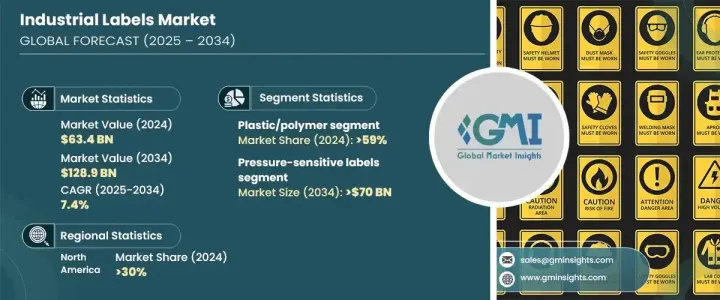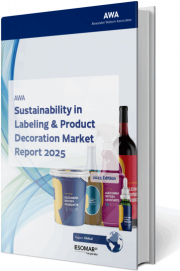
|
시장보고서
상품코드
1684576
산업용 라벨 시장 : 기회, 성장 촉진요인, 산업 동향 분석(2025-2034년)Industrial Labels Market Opportunity, Growth Drivers, Industry Trend Analysis, and Forecast 2025 - 2034 |
||||||
세계의 산업용 라벨 시장은 2024년에 634억 달러에 이르렀으며, 2025년부터 2034년에 걸쳐 7.4%의 연평균 성장률(CAGR)로 성장할 것으로 예측됩니다.
공급망 추적성, 브랜드 보호 및 제품 안전에 대한 강조가 증가함에 따라 RFID 및 스마트 라벨과 같은 고급 라벨링 기술의 채택이 증가하고 있습니다. 이러한 수요는 엄격한 규제 표준을 충족하고 운영 효율성을 보장하기 위해 고성능 라벨이 필요한 자동차, 의료 및 전자상거래와 같은 산업의 급속한 성장으로 인해 더욱 증폭되고 있습니다.

게다가, 친환경 라벨 솔루션에 대한 필요성이 증가함에 따라 지속 가능성에 대한 관심이 높아지면서 제조업체는 변화하는 소비자 선호도에 맞춰 혁신하고 적응해야 합니다. 글로벌 무역과 물류가 급증함에 따라 산업용 라벨은 재고 관리 개선, 위조 방지, 공급망 전반의 제품 가시성 향상에 중요한 역할을 하고 있습니다. 신흥 경제국에서도 산업이 글로벌 표준에 맞춰 프로세스를 현대화하면서 상당한 성장세를 보이고 있어 시장 확대에 더욱 박차를 가하고 있습니다.
| 시장 범위 | |
|---|---|
| 시작 연도 | 2024년 |
| 예측 연도 | 2025-2034년 |
| 시작 금액 | 634억 달러 |
| 예측 금액 | 1,289억 달러 |
| CAGR | 7.4% |
시장은 재료별로 금속, 플라스틱/폴리머, 종이로 세분화됩니다. 이 중 플라스틱/폴리머 부문은 2024년 59%의 점유율로 시장을 지배할 것으로 예상됩니다. 이 부문의 인기는 다용도성, 내구성, 비용 효율성에서 비롯됩니다. 폴리프로필렌과 폴리에틸렌과 같은 소재는 습기, 화학물질, 온도 변화에 대한 저항성이 뛰어나 다양한 산업 분야에 이상적입니다. 이러한 가볍고 유연한 소재는 효율적인 대량 생산이 가능하여 제조, 물류, 소비재 등 다양한 분야의 라벨 제작 요구 사항을 충족합니다.
메커니즘에 따라 감압식 라벨, 접착식 라벨, 열전사 라벨 등으로 시장이 나뉩니다. 감압식 라벨 부문은 연평균 8%의 놀라운 성장률로 2034년까지 700억 달러에 달할 것으로 예상됩니다. 이러한 성장은 자동차, 의료 및 소비재와 같은 산업 전반에서 선호되는 적응성과 사용 편의성에 기인합니다. 이러한 라벨은 추가 접착제 없이도 접착되므로 효율적이고 비용 효율적인 작업을 보장합니다. 뛰어난 내구성, 뛰어난 인쇄 품질 및 빠른 적용 프로세스는 대량 생산 환경에서의 채택을 더욱 향상시킵니다.
북미의 산업용 라벨 시장은 2024년 전 세계 점유율의 30%를 차지하며 미국이 전 세계에서 가장 큰 시장 중 하나로 선두를 달리고 있습니다. 미국 시장은 강력한 제조 기반과 번성하는 자동차, 의료 및 전자상거래 산업의 혜택을 받고 있습니다. 공급망 운영을 최적화하고 브랜드 무결성을 보호하기 위해 RFID 및 스마트 라벨을 비롯한 고급 솔루션에 대한 수요가 증가하고 있습니다. 제조업체들이 친환경 소재와 관행을 점점 더 많이 채택하면서 지속 가능성이 핵심 초점이 되고 있습니다. 디지털 인쇄 및 자동화된 라벨 제작 시스템과 같은 기술 발전이 시장 성장을 더욱 촉진하여 기업이 효율성을 높이고 진화하는 소비자의 기대에 부응할 수 있도록 돕고 있습니다.
목차
제1장 조사 방법과 조사 범위
- 시장 범위와 정의
- 기본 추정과 계산
- 예측 계산
- 데이터 소스
- 1차
- 2차
- 유료
- 공적
제2장 주요 요약
제3장 업계 인사이트
- 업계 생태계 분석
- 밸류체인에 영향을 주는 요인
- 변혁
- 장래 전망
- 제조업체
- 유통업체
- 이익률 분석
- 주요 뉴스와 대처
- 규제 상황
- 영향요인
- 성장 촉진요인
- 공급망의 추적성에 대한 수요 증가
- 제품 안전 및 보안에 대한 관심 증가
- 전자상거래와 소매 부문의 성장
- 위조 제품에 대한 우려 증가
- 산업 부문 확대
- 업계의 잠재적 리스크 및 과제
- 위조 라벨링 솔루션
- 기술 통합 비용
- 성장 촉진요인
- 성장 가능성 분석
- Porter's Five Forces 분석
- PESTEL 분석
제4장 경쟁 구도
- 소개
- 기업의 시장 점유율 분석
- 경쟁 포지셔닝 매트릭스
- 전략 전망 매트릭스
제5장 시장 추계 및 예측 : 제품 유형별(2021-2034년)
- 주요 동향
- 경고/보안 라벨
- 브랜드 라벨
- 추적 라벨
- 식별 라벨
- 기타
제6장 시장 추계 및 예측 : 재료별(2021-2034년)
- 주요 동향
- 금속
- 플라스틱/폴리머
- 종이
제7장 시장 추계 및 예측 : 메커니즘별(2021-2034년)
- 주요 동향
- 감압 라벨
- 접착제 라벨
- 열전사 라벨
- 기타
제8장 시장 추계 및 예측 : 인쇄 기술별(2021-2034년)
- 주요 동향
- 디지털 인쇄
- 리소그래피
- 플렉소 인쇄
- 스크린 인쇄
- 기타
제9장 시장 추계 및 예측 : 최종 이용 산업별(2021-2034년)
- 주요 동향
- 운송 및 물류
- 건설
- 자동차
- 의료
- 기타
제10장 시장 추계 및 예측 : 지역별(2021-2034년)
- 주요 동향
- 북미
- 미국
- 캐나다
- 유럽
- 영국
- 독일
- 프랑스
- 이탈리아
- 스페인
- 러시아
- 아시아태평양
- 중국
- 인도
- 일본
- 한국
- 호주
- 라틴아메리카
- 브라질
- 멕시코
- 중동 및 아프리카
- 남아프리카
- 사우디아라비아
- 아랍에미리트(UAE)
제11장 기업 프로파일
- 3M
- Avery Dennison
- AWT
- Camcode
- CCL Industries
- Dura-ID
- DYMO
- Fuji Seal
- HERMA
- HID Global
- ID Image
- Inovar
- Linepro Controls
- MaverickLabel
- Multi-Color
- Novexx Solutions
- Resource Label
- SATO
- Taghleef
- UPM Raflatac
- Zebra Technologies
The Global Industrial Labels Market reached USD 63.4 billion in 2024 and is anticipated to expand at a robust CAGR of 7.4% between 2025 and 2034. The growing emphasis on supply chain traceability, brand protection, and product safety is driving the adoption of advanced labeling technologies such as RFID and smart labels. This demand is further amplified by the rapid growth of industries like automotive, healthcare, and e-commerce, which require high-performance labels to meet stringent regulatory standards and ensure operational efficiency.

Additionally, the rising need for eco-friendly labeling solutions reflects the increasing focus on sustainability, compelling manufacturers to innovate and adapt to shifting consumer preferences. With the surge in global trade and logistics, industrial labels play a critical role in improving inventory management, preventing counterfeiting, and enhancing product visibility throughout the supply chain. Emerging economies are also witnessing significant growth as industries modernize their processes to align with global standards, further fueling market expansion.
| Market Scope | |
|---|---|
| Start Year | 2024 |
| Forecast Year | 2025-2034 |
| Start Value | $63.4 Billion |
| Forecast Value | $128.9 Billion |
| CAGR | 7.4% |
The market is segmented by material into metal, plastic/polymer, and paper. Among these, the plastic/polymer segment dominated the market with a 59% share in 2024. This segment's popularity stems from its versatility, durability, and cost-effectiveness. Materials like polypropylene and polyethylene offer excellent resistance to moisture, chemicals, and temperature fluctuations, making them ideal for various industrial applications. These lightweight and flexible materials enable efficient mass production, catering to the diverse labeling needs of sectors such as manufacturing, logistics, and consumer goods.
By mechanism, the market includes pressure-sensitive labels, glue-applied labels, heat transfer labels, and others. The pressure-sensitive labels segment is projected to grow at an impressive CAGR of 8%, reaching USD 70 billion by 2034. This growth is attributed to their adaptability and ease of use, making them a preferred choice across industries like automotive, healthcare, and consumer goods. These labels adhere without additional adhesives, ensuring efficient and cost-effective operations. Their superior durability, excellent print quality, and quick application process further enhance their adoption in high-volume production environments.
North America industrial labels market accounted for 30% of the global share in 2024, with the United States leading as one of the largest markets worldwide. The US market benefits from its strong manufacturing base and thriving automotive, healthcare, and e-commerce industries. Demand for advanced solutions, including RFID and smart labels, is rising to optimize supply chain operations and protect brand integrity. Sustainability is becoming a key focus, with manufacturers increasingly adopting eco-friendly materials and practices. Technological advancements, such as digital printing and automated labeling systems, are further driving market growth, helping businesses enhance efficiency and align with evolving consumer expectations.
Table of Contents
Chapter 1 Methodology & Scope
- 1.1 Market scope & definitions
- 1.2 Base estimates & calculations
- 1.3 Forecast calculations
- 1.4 Data sources
- 1.4.1 Primary
- 1.4.2 Secondary
- 1.4.2.1 Paid sources
- 1.4.2.2 Public sources
Chapter 2 Executive Summary
- 2.1 Industry synopsis, 2021-2034
Chapter 3 Industry Insights
- 3.1 Industry ecosystem analysis
- 3.1.1 Factor affecting the value chain
- 3.1.2 Disruptions
- 3.1.3 Future outlook
- 3.1.4 Manufacturers
- 3.1.5 Distributors
- 3.2 Profit margin analysis
- 3.3 Key news & initiatives
- 3.4 Regulatory landscape
- 3.5 Impact forces
- 3.5.1 Growth drivers
- 3.5.1.1 Increasing demand for supply chain traceability
- 3.5.1.2 Rising focus on product safety and security
- 3.5.1.3 Growth in e-commerce and retail sectors
- 3.5.1.4 Increasing concerns about counterfeit products
- 3.5.1.5 Expansion of industrial sectors
- 3.5.2 Industry pitfalls & challenges
- 3.5.2.1 Counterfeit labeling solutions
- 3.5.2.2 Technological integration costs
- 3.5.1 Growth drivers
- 3.6 Growth potential analysis
- 3.7 Porter's analysis
- 3.8 PESTEL analysis
Chapter 4 Competitive Landscape, 2024
- 4.1 Introduction
- 4.2 Company market share analysis
- 4.3 Competitive positioning matrix
- 4.4 Strategic outlook matrix
Chapter 5 Market Estimates & Forecast, By Product Type, 2021-2034 (USD Billion & Units)
- 5.1 Key trends
- 5.2 Warning/security labels
- 5.3 Branding labels
- 5.4 Tracking labels
- 5.5 Identification labels
- 5.6 Others
Chapter 6 Market Estimates & Forecast, By Material, 2021-2034 (USD Billion & Units)
- 6.1 Key trends
- 6.2 Metal
- 6.3 Plastic/polymer
- 6.4 Paper
Chapter 7 Market Estimates & Forecast, By Mechanism, 2021-2034 (USD Billion & Units)
- 7.1 Key trends
- 7.2 Pressure-sensitive labels
- 7.3 Glue-applied labels
- 7.4 Heat transfer labels
- 7.5 Others
Chapter 8 Market Estimates & Forecast, By Printing Technology, 2021-2034 (USD Billion & Units)
- 8.1 Key trends
- 8.2 Digital printing
- 8.3 Lithography
- 8.4 Flexography
- 8.5 Screen printing
- 8.6 Others
Chapter 9 Market Estimates & Forecast, By End Use Industry, 2021-2034 (USD Billion & Units)
- 9.1 Key trends
- 9.2 Transportation & logistics
- 9.3 Construction
- 9.4 Automotive
- 9.5 Healthcare
- 9.6 Others
Chapter 10 Market Estimates & Forecast, By Region, 2021-2034 (USD Billion & Units)
- 10.1 Key trends
- 10.2 North America
- 10.2.1 U.S.
- 10.2.2 Canada
- 10.3 Europe
- 10.3.1 UK
- 10.3.2 Germany
- 10.3.3 France
- 10.3.4 Italy
- 10.3.5 Spain
- 10.3.6 Russia
- 10.4 Asia Pacific
- 10.4.1 China
- 10.4.2 India
- 10.4.3 Japan
- 10.4.4 South Korea
- 10.4.5 Australia
- 10.5 Latin America
- 10.5.1 Brazil
- 10.5.2 Mexico
- 10.6 MEA
- 10.6.1 South Africa
- 10.6.2 Saudi Arabia
- 10.6.3 UAE
Chapter 11 Company Profiles
- 11.1 3M
- 11.2 Avery Dennison
- 11.3 AWT
- 11.4 Camcode
- 11.5 CCL Industries
- 11.6 Dura-ID
- 11.7 DYMO
- 11.8 Fuji Seal
- 11.9 HERMA
- 11.10 HID Global
- 11.11 ID Images
- 11.12 Inovar
- 11.13 Linepro Controls
- 11.14 MaverickLabel
- 11.15 Multi-Color
- 11.16 Novexx Solutions
- 11.17 Resource Label
- 11.18 SATO
- 11.19 Taghleef
- 11.20 UPM Raflatac
- 11.21 Zebra Technologies



















